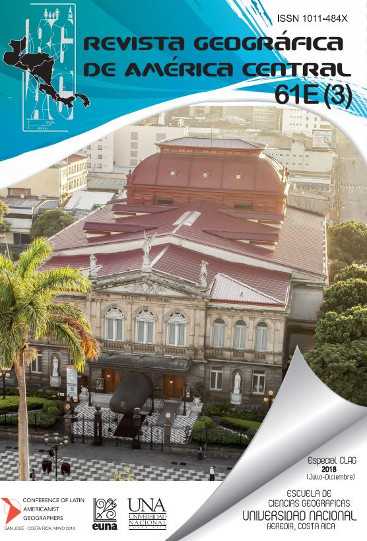Deterritorialization and citizenship of the Guaymí.
DOI:
https://doi.org/10.15359/rgac.61-3.27Keywords:
Cultural territories-ethnoterritories-guaymí-citizenship-deterritorialization.Abstract
This is an experience where geography, anthropology and history come together in order to reveal the insurgent and anti-colonial identity of western Panama, particularly of the Guaymí people. After national history it is necessary to discover regional history and ethnic history in particular, both absorbed by homogenizing and totalizing discourses where the polyphony of dissenting voices has been erased. From the late nineteenth and early twentieth centuries the idea of "empty space" coexisted and competed with that of "wild space", which is possible to trace in the press, official documentation and writings of intellectuals. In this issue I want to take a tour of the strategies (political, economic and ideological) of the State and the elites to tear down the ethnoterritory and administer the indigenous population and its assets in the framework of a National State in consolidation and an exclusive national identity in the process of construction.
References
Barabas, A. (2008). Cosmovisiones y etnoterritorialidad en las culturas indígenas de Oaxaca. En Antípoda. Revista de Antropología y Arquelogía, 7, 119-139.
Bartolomé, M. (2010). Interculturalidad y territorialidades confrontadas en América Latina. En RUNA, 1, 9-29.
Constenla Umaña, A. (1991). Las lenguas del área intermedia. Introducción a su estudio areal. San José: Costa Rica. Editorial UCR.
Cooke, R. (1982), “Los guaymíes si tienen historia”, El pueblo guaymí y su futuro. ¿Quién dijo que estamos cansados de ser indios?, Ciudad de Panamá: Panamá. Editorial Impretex, 26-64.
Guevara Berger, M. (2000). Perfil de los pueblos indígenas de Costa Rica. Informe final. San José: Costa Rica. Recuperado: http://pueblosindigenas.odd.ucr.ac.cr/images/documentos/pdf/Perfil%20de%20pueblos%20indigenas%20en%20Costa%20Rica.pdf
Hasemann, G, Lara Pinto, G y Cruz Sandoval, P. (1996). Los indios de Centroamérica. Madrid: España. MAPFRE.
Jaén Suárez, Omar. (1997).La región de los Llanos del Chirú. Un estudio de historia rural panameña. Ciudad de Panamá: Panamá. INAC.
Linares, O. (1970). Patrones de poblamiento prehispánicos comparados con los modernos en Bocas del Toro, Panamá. En Revista Hombre y cultura, 1, 56-67.
Mallon, F. (1996). Constructing mestizaje in Latin America: Authenticity, marginality and gender in the claiming of ethnic identities. En The Journal of Latin American and Caribbean Anthropology, (2)1, 171-172.
Quesada, J. (2012). Las lenguas indígenas de la Costa Rica actual. Revista WANI, 68, 19-24.
Roulet, F, Navarro Floria. (2005). De soberanos externos a rebeldes internos: la domesticación discursiva y legal de la cuestión indígena en el tránsito del siglo XVIII al XX. En Revista TEFROS, 1, 1-41.
Sandner, G. (1981). Estructuración espacio-político-geográfica y la geopolítica en la Región Caribe. En Revista geográfica de América Central, 13-14, 41-66.
Santos-Granero, F. (2005). “Writing history into the landscape: Yanesha notions of space and territoriality”, The Land within: Indigenous territory and the perception of environment, Copenhagen, Dinamarca: Editorial IWGIA.
Soto Quirós, R y Díaz-Arias, D. (2007). Mestizaje, indígenas e identidad nacional en Centroamérica: De la Colonia a las Repúblicas Liberales. San José: Costa Rica. Editorial FLACSO.
Stutzman, R. (1981). “El mestizaje: an all-inclusive ideology of exclusion”. Cultural transformations and ethnicity in modern Ecuador, Illinois: Estados Unidos. Editorial Urbana.
Taracena Arriola, A. (1999). Región e historia, En Desacatos. Revista de Ciencias Sociales, 1, Recuperado: http://www.redalyc.org/articulo.oa?id=13900104>.
Taracena Arriola, A. (2008). Propuesta de definición histórica para región. En Estudios de historia moderna y contemporánea de México, 35, 181-204.
Young, P. (1968).The ngawbe: an analysis of the economy and social structure of the western guaymí of Panamá. Tesis doctoral. University of Illinois. Estados Unidos. (pp.471).
Young, P. (2014). “Women’s Roles and Responses to Globalization in Ngäbe Communities”, Mestizaje and Globalization, Transformations of Identity and Power, Arizona: Estados Unidos: The University of Arizona Press.
Downloads
Published
How to Cite
Issue
Section
License
Proposed policy for journals offering Open Access
Authors publishing their works in the Journal acknowledge and agree to the following terms:
a) Authors retain the copyrights to their works and guarantee the Journal the right to be the first to publish their works, under the Creative Commons License Attribution-NonCommercial-ShareAlike 4.0 International, CC BY-NC-SA 4.0 International (https://creativecommons.org/licenses/by-nc-sa/4.0/deed.es), which allows others to share works upon complying with the acknowledgment of authorship and mention of the Journal as the original publisher of the work.
b) Authors are permitted to separately establish additional agreements for the non-exclusive distribution of the official edition of the work published in the Journal (for example, authors may desire to place the work in an institutional repository or incorporate it into a book that is to published elsewhere) so long they acknowledgment to recognize the Journal as the original publisher. The aforementioned additional agreements must respect the terms of the non-profit character and sharing philosophy of the original license (CC BY-NC-SA 4.0 International, https://creativecommons.org/licenses/by-nc-sa/4.0/deed.es).
c) Authors are encouraged to archive the post-print or editor/PDF version in Open Access repositories.






 REVGEO is licensed under https://creativecommons.org/licenses/by-nc-sa/4.0/deed.es
REVGEO is licensed under https://creativecommons.org/licenses/by-nc-sa/4.0/deed.es
.svg_4.png)

_(1).png)
_(1)_(1)_(1)_1.png)
(2)(1)(1)(1).png)
